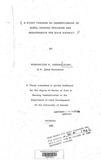| dc.description.abstract | This thesis constitutes a study of rural housing provision and requirements in Kenya, with particular reference to Siaya District. The study developed from a statement of the problem that there is inadequate housing in rural areas of Siaya District , It is,' however, not known- with any precision what is the immediate cause of this state of affairs. This study therefore set out to investigate the possible causes of housing quality, and examines the problems of providing decent housing in rural areas in the light of the. locally available building materials, and available human and economic resources.The study is therefore not a comparison of the various houses but an examination of the problems associated with rural housing conditions , In measuring the housing quality, the study used multiple linear regression analysis, in which. the housing quality measured in points was the dependent variable, with various factors such as income, age of the house, building materials, household size etc. were independent variables. It is noted that the provision of proper and decent housing in the rural areas of Kenya is and wit! remain- a big problem for a long time to come. Housing in rural areas tends to' be dismissed as a low priority issue. This is due partly to the fact that shelter construction, improvement and maintenance are viewed as semi-automatic self help processes taking place in homogeneous setting under no constraints in terms of land, availability of local building materials , building skills, financing, and of course legislation. Designing rural settlements within the African traditional architectural context, using improved indigenous (or traditional) building materials after careful studies of traditional built environment and knowledge of the logic behind' it, can be a great achievement to the government. .It is true that some people in the rural areas can these days afford to -build semi-pemanent or permanent houses and thus, neglect the use of indigenous materials , The problem however is that there 'is increasingly high cost of building materials and lack of regular income b-y people in the rural areas. Rural housing should be such that majority of people 'living there can afford it by utilizing the locally available traditional construction materials and skills at minimum cost. There are three parts to this study . The first section comprises the introductory chapters covering the general irrtroductory formalities of the study. It sets the premise against which the housing conditions in Siaya District is examined. This section reviews concepts as they relate to rural housing, i.e. house form determinants, African architecture, and determinants of housing need. The second part of the thesis consists of two chapters. There is a chapter giving background information on the housing development process in Kenya and the various roles played by .National Housing Corporation and Housing Finance Company of Kenya (HFCK). At the moment the role of these government agencies has been found to be minimal, partlcularly HFCK in providing housing in rural areas of Kenya. The other chapter in this part examines the general characteristics of the study area, Siaya District, and the building practices. The study area portray s problems related to housing conditions and the available amenities. The last par t of the thesis consists of two chapters. One chapter provides an evaluation and analysis of information collected mainly through questionnaire administration and field observations regarding the housing conditions. in Siaya District and the variables that influence the conditions. The results obtained in the main revealed striking variations in housing conditions, in terms of, building materials used, sizes of houses, age, architectural style, quality etc. in the sub-areas of Siaya District. The majority of the .people use locally available building materials in providing themselves with housing. The houses are of average quality depending on the frequency of maintenance and repairs carried out. However, the proportion of houses which are inadequate is high, and tr.Is has unpleasant implications to. the national housing policy of providing every household with a decent dwelling. The last chapter is a summary of the recommendations and conclusions. The conclusions are based on the theoretical concepts defined in section one and the, empirical findings. It is here discussed the direction which rural housing should take. It is considered that rural housing should be an integral part of a national housing policy and not to be left to the rural households themselves because lack of a clear policy renders the achievement of housing policy objectives difficult. | |



